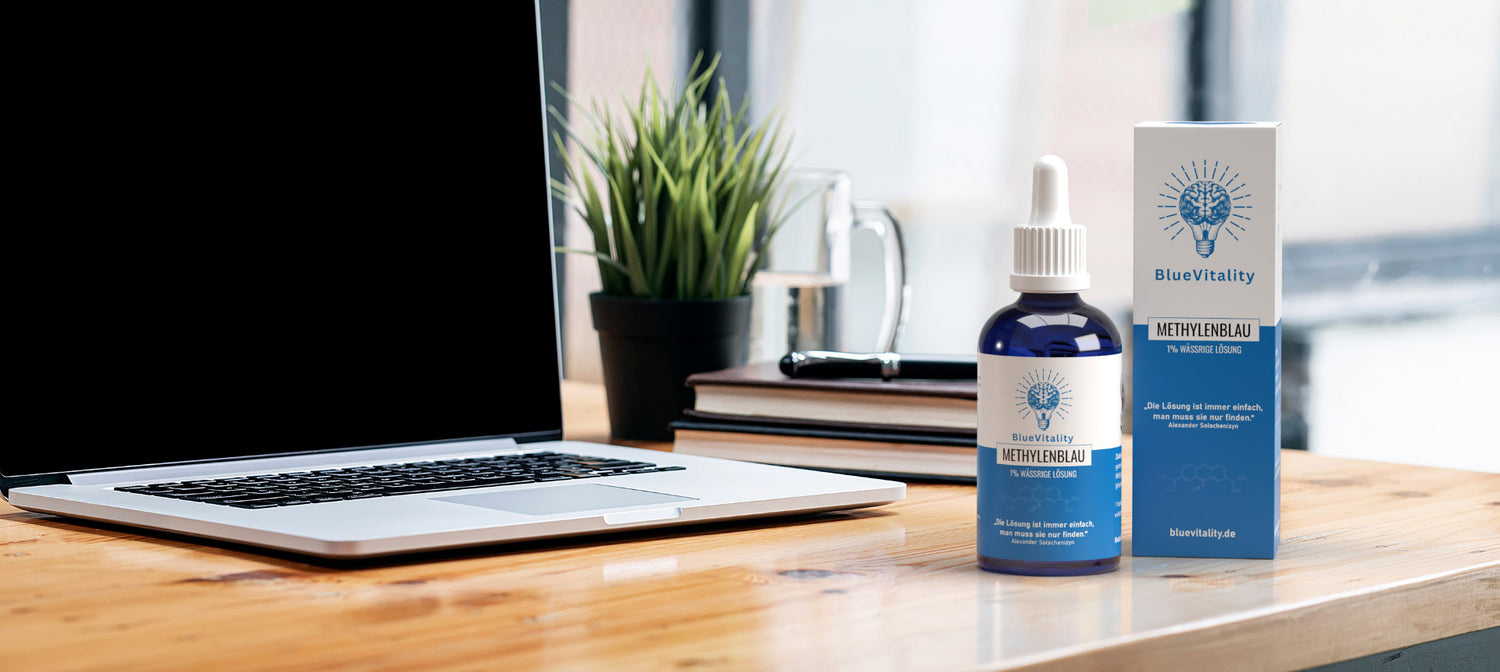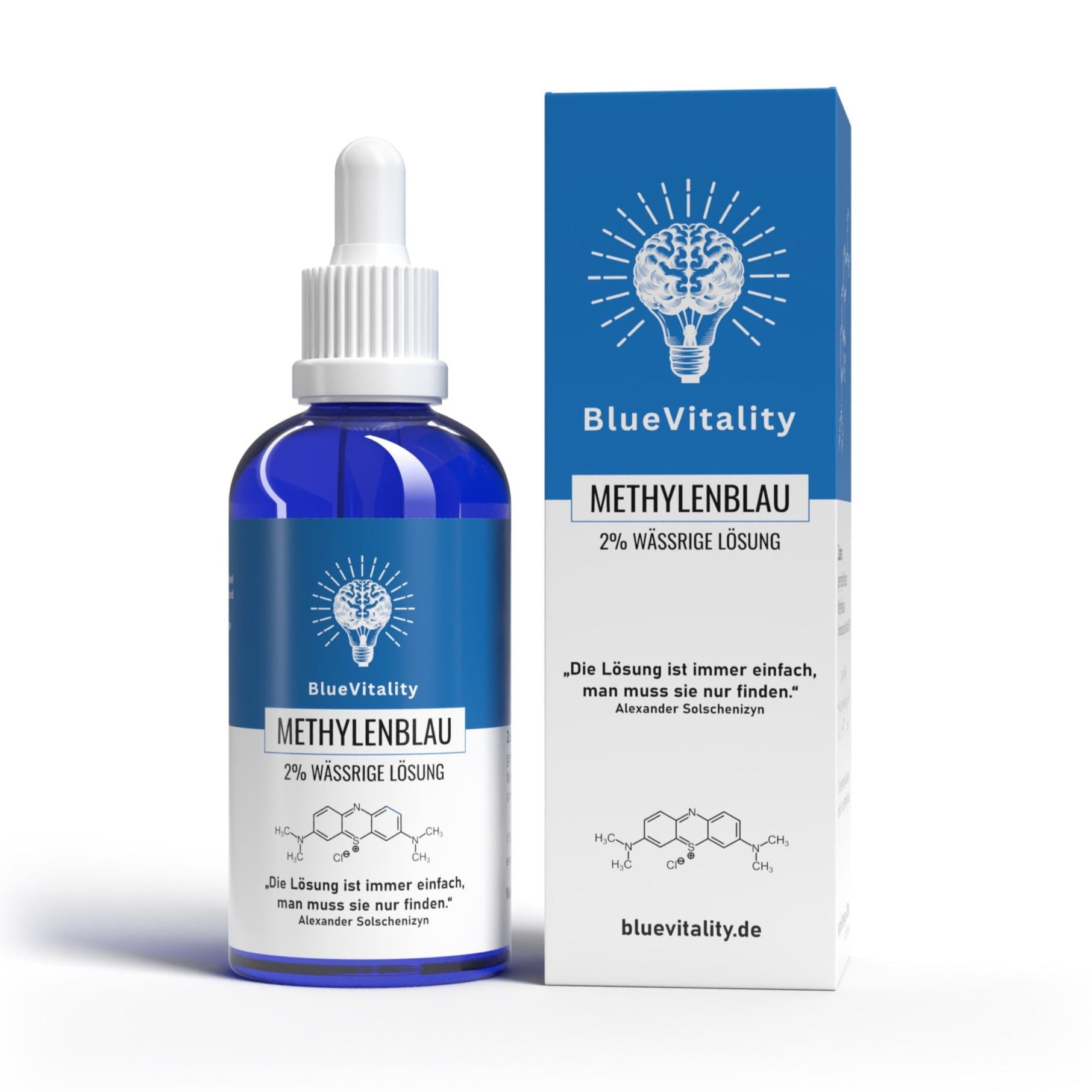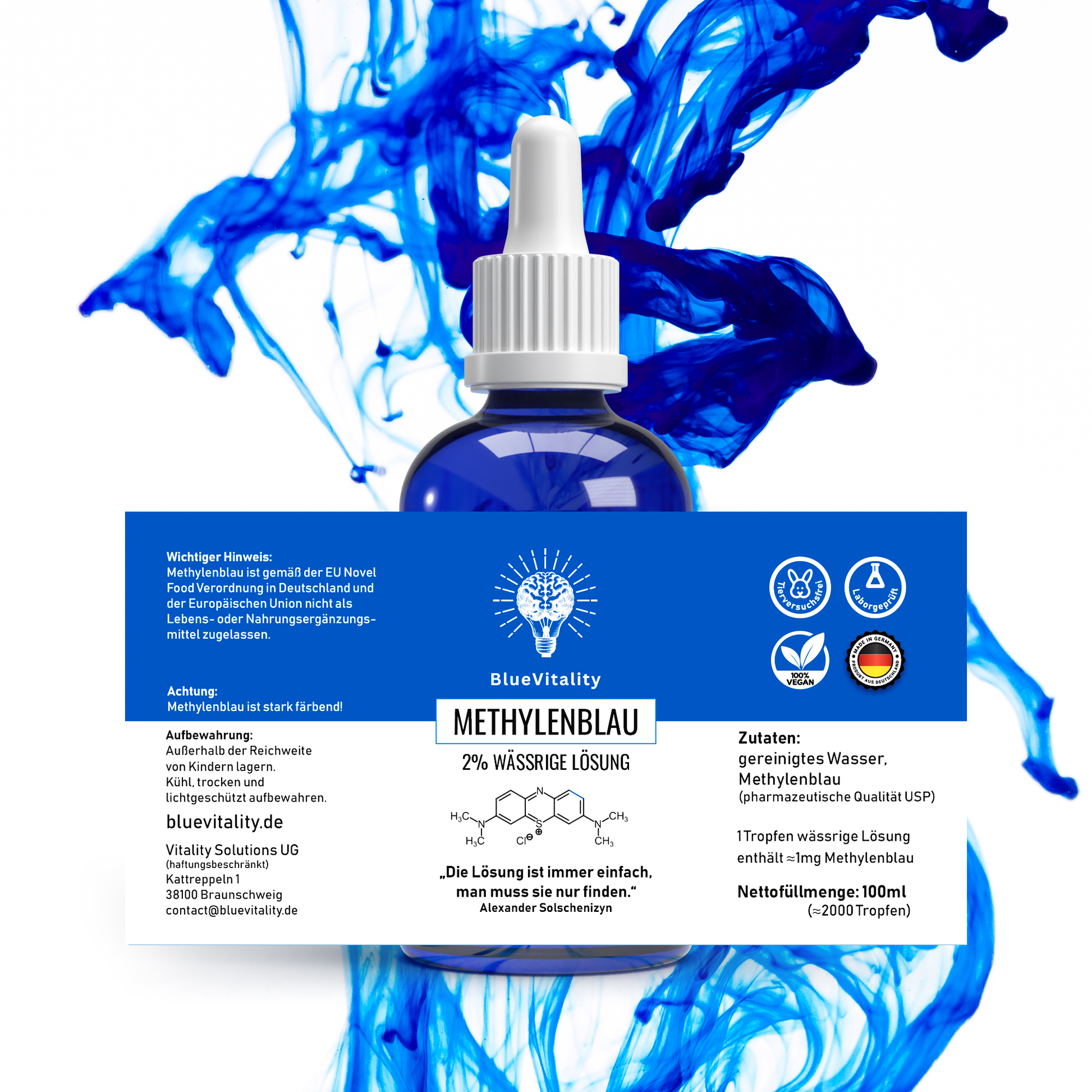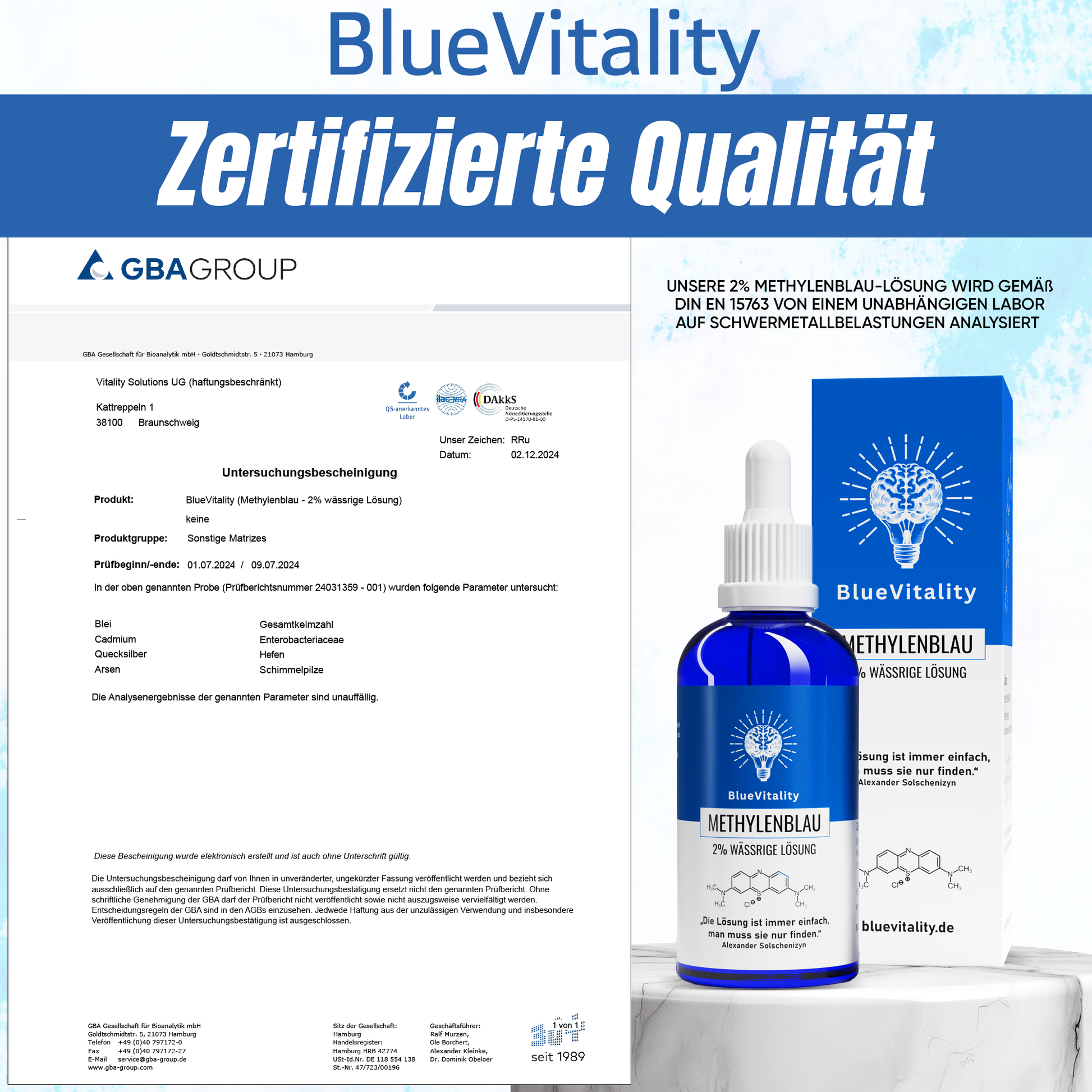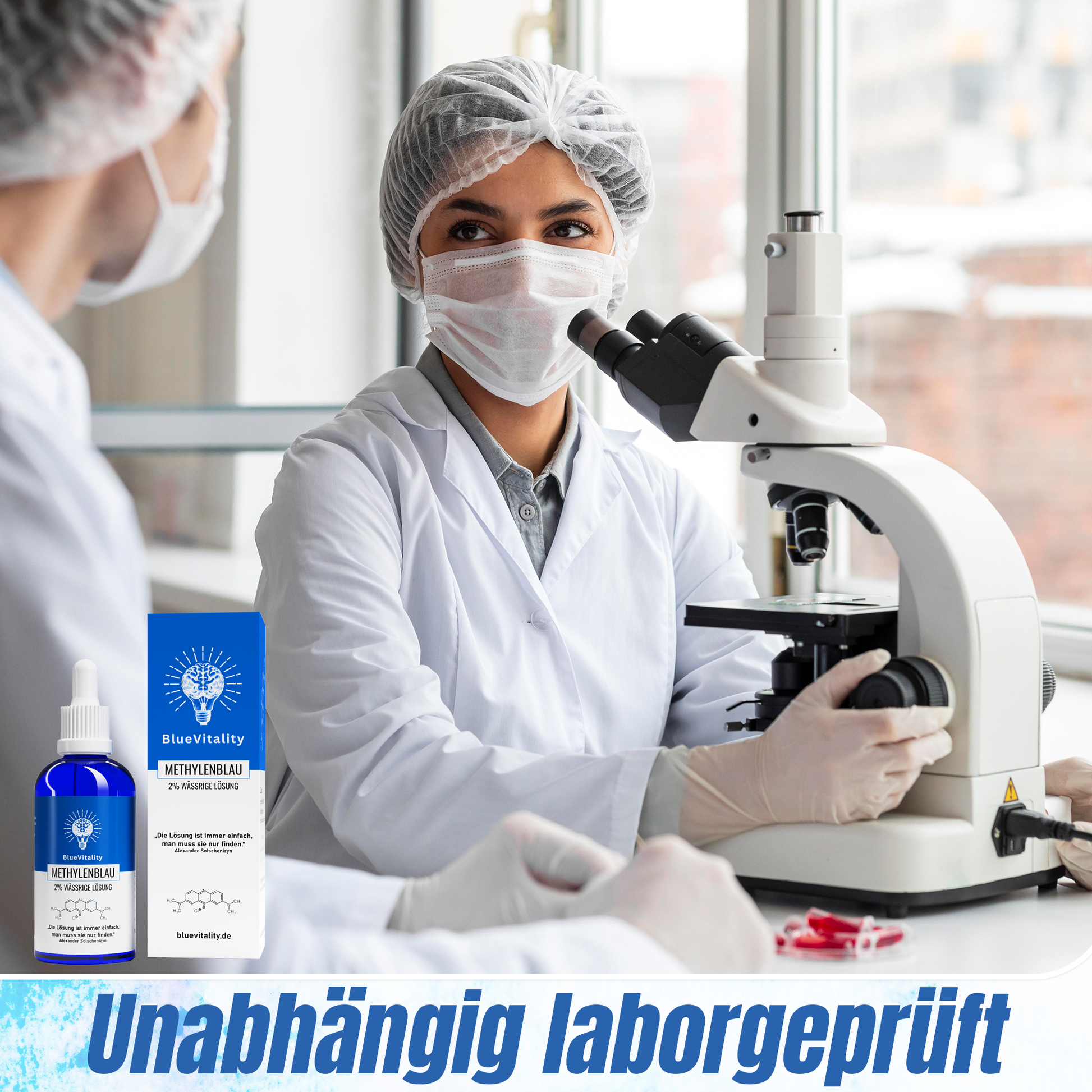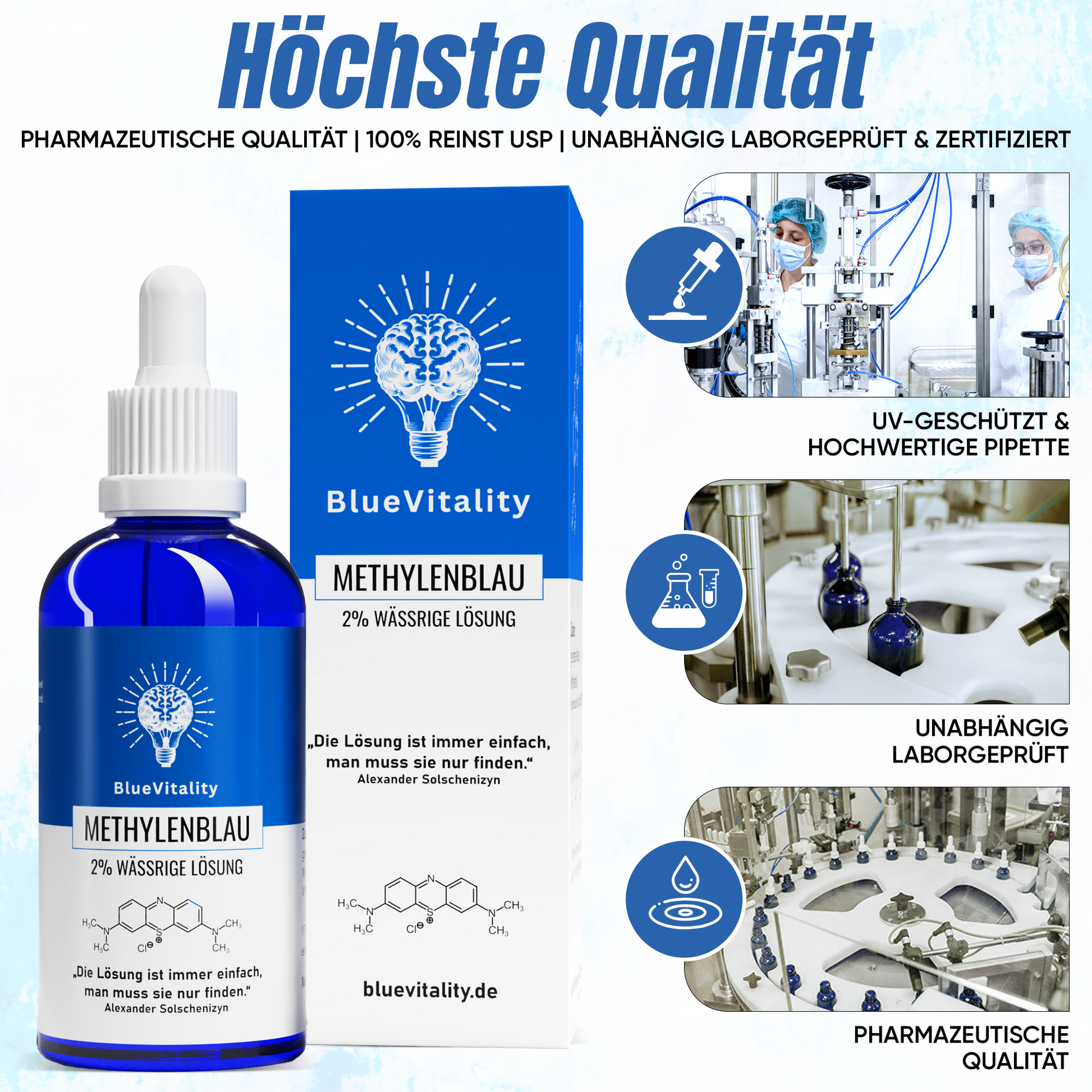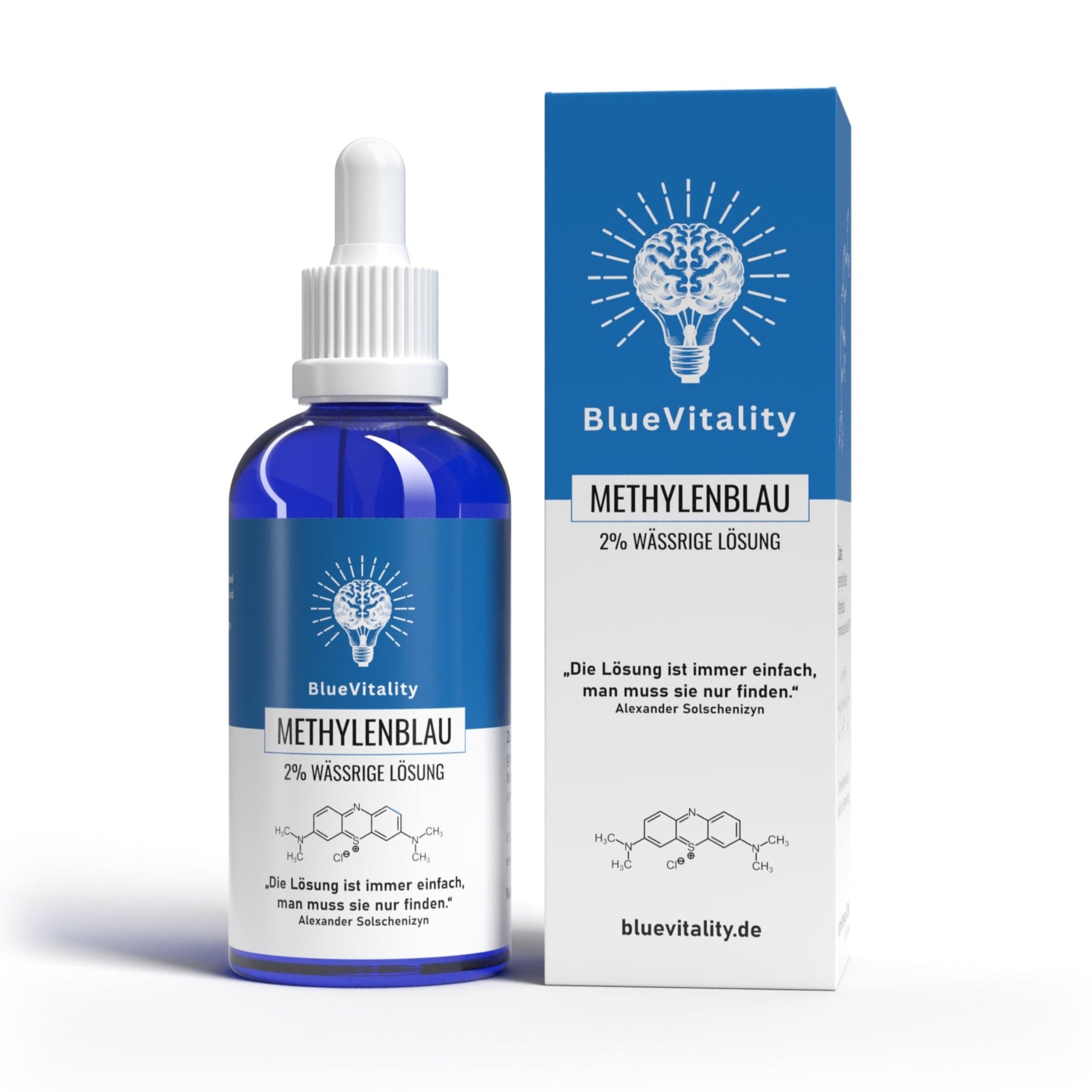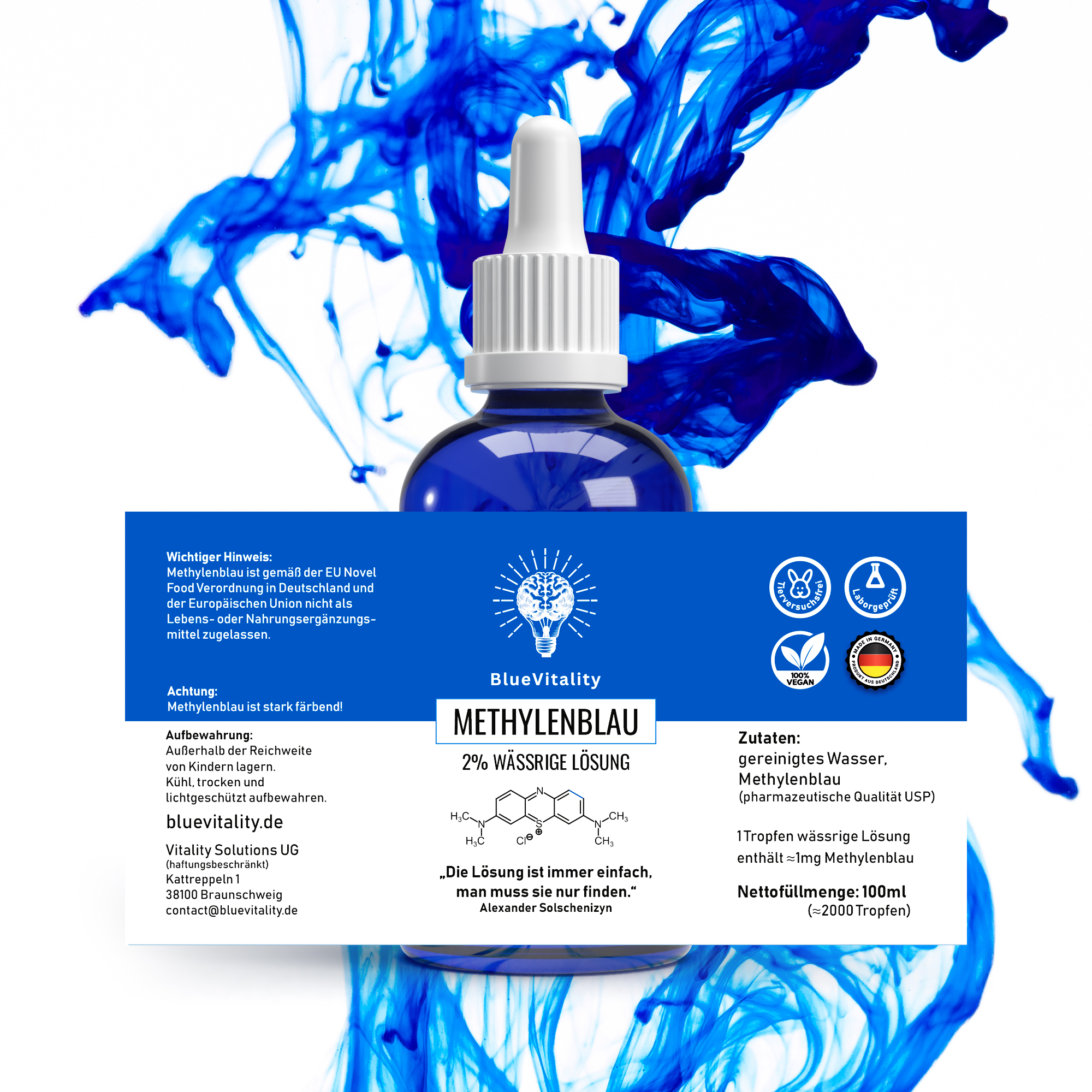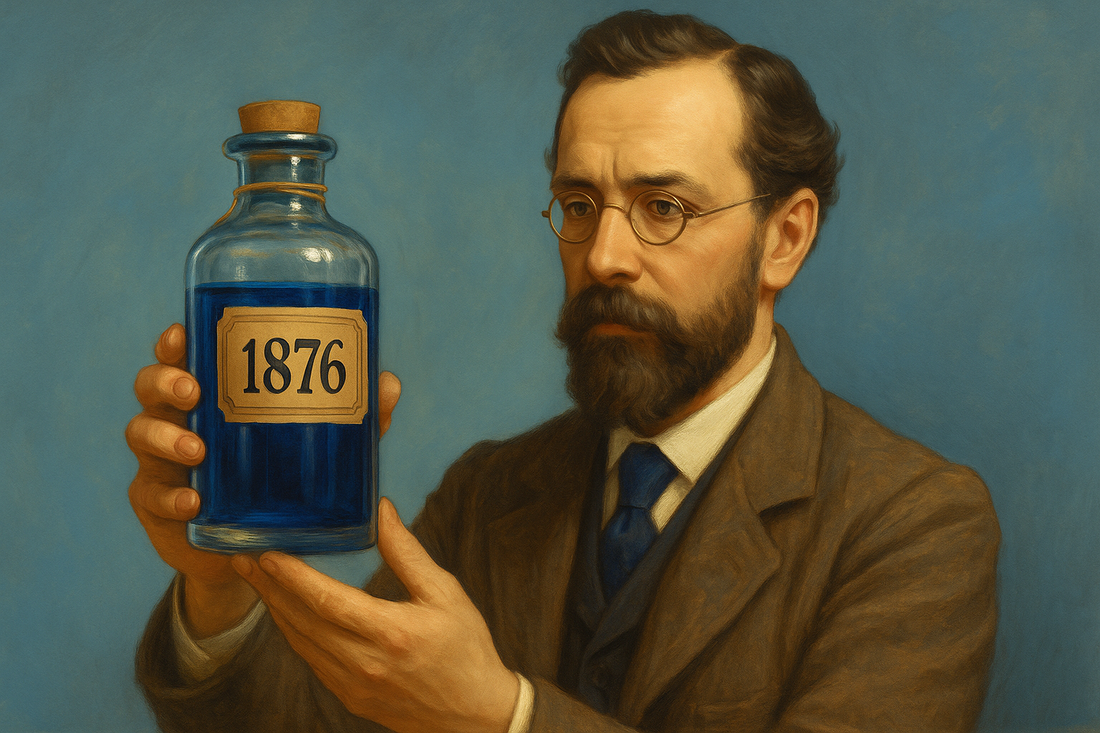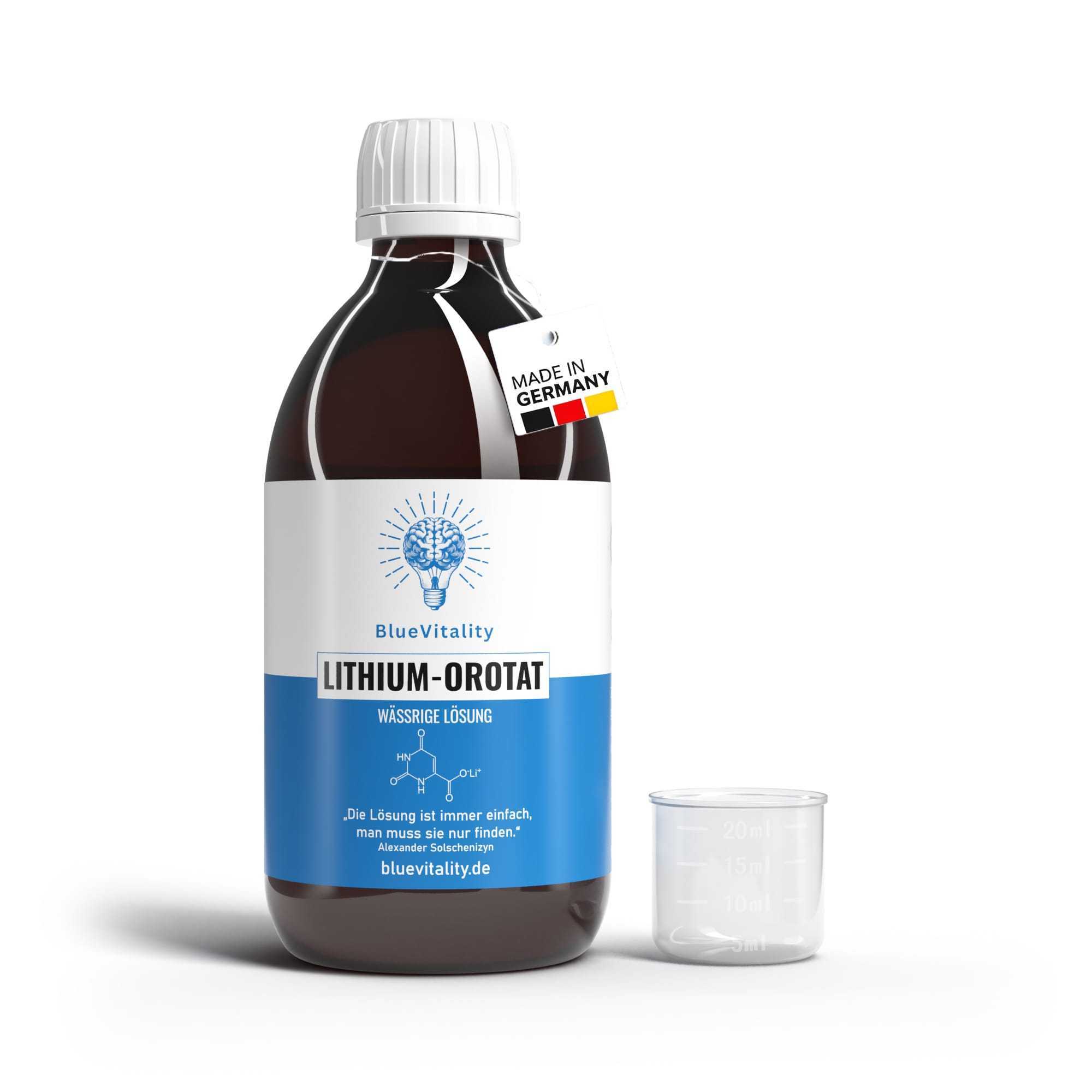Methylene blue is a unique active ingredient with an exciting history in medicine, research and diagnostics.
Here you will find clearly presented information, current scientific findings and answers to frequently asked questions – compact and based on the latest research.
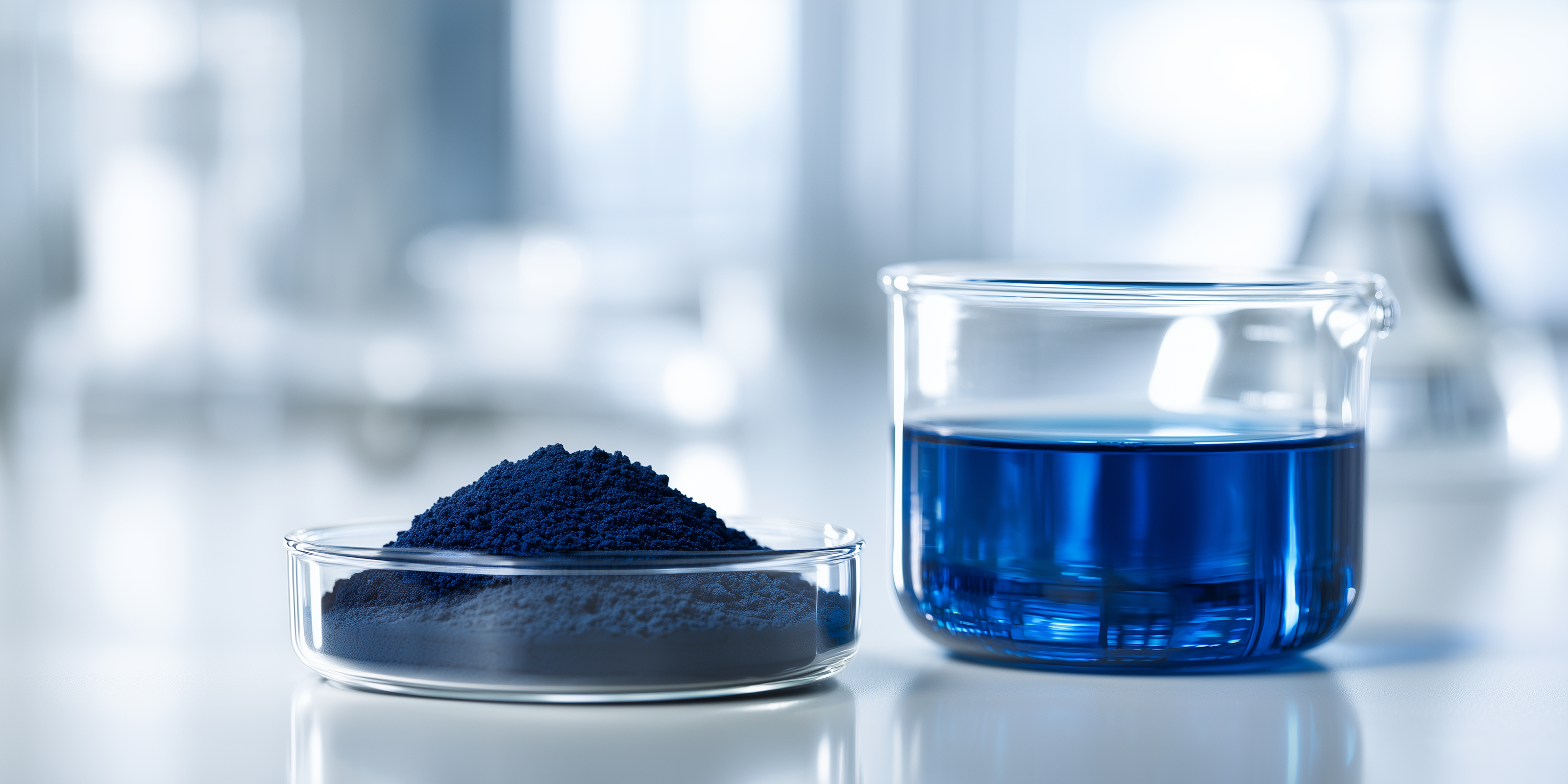
What is methylene blue?
Methylene blue is a synthetic compound used as a dye and medication. Chemically, it belongs to the thiazine dye group and is used in various fields, including medicine, biology, and chemistry. In medicine, it is often used to treat methemoglobinemia , a condition in which the blood cannot transport sufficient oxygen . It also serves as an antiseptic and diagnostic agent. In microscopy, it is used as a stain to visualize structures in cells and tissues .
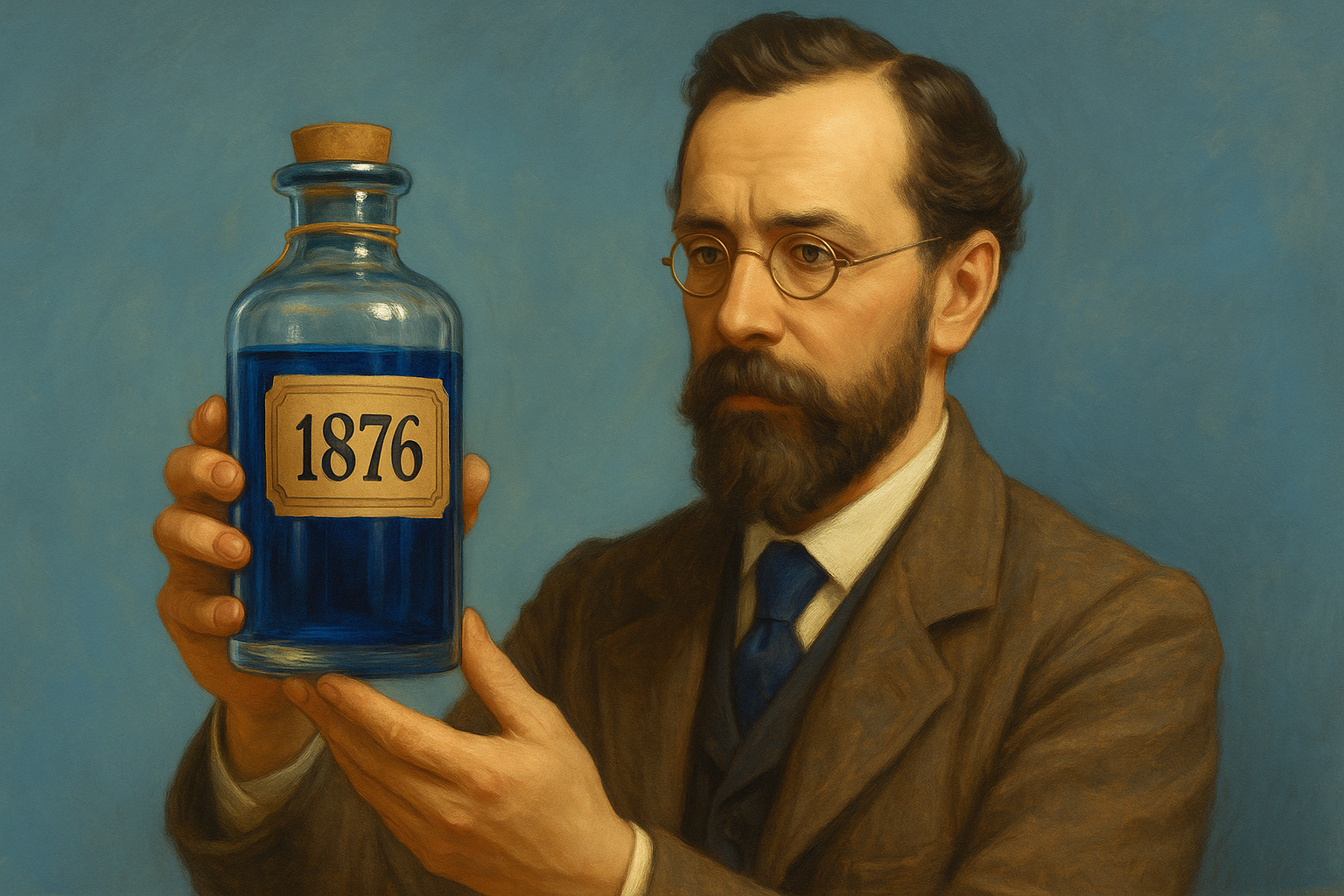
Since when has methylene blue been used?
Methylene blue was first synthesized in 1876 by the German chemist Heinrich Caro and quickly found applications in medicine and microscopy. At the beginning of the 20th century, methylene blue was one of the first synthetic drugs used to treat malaria . Since then, it has established itself in various medical and scientific fields.

How is methylene blue used?
According to the EU Novel Food Regulation, methylene blue is not approved as a food or food supplement in Germany and the EU and must not be consumed!
Areas of application:
- Medicine: intravenously for the treatment of methemoglobinemia, orally for certain urinary tract infections, topically in low concentrations as an antiseptic.
- Diagnostics: for staining tissues and cells under the microscope.
- Aquaristics: against fungal infections and parasites in fish.
- Laboratory: as a stain for cell and tissue structures in microscopy and biology.
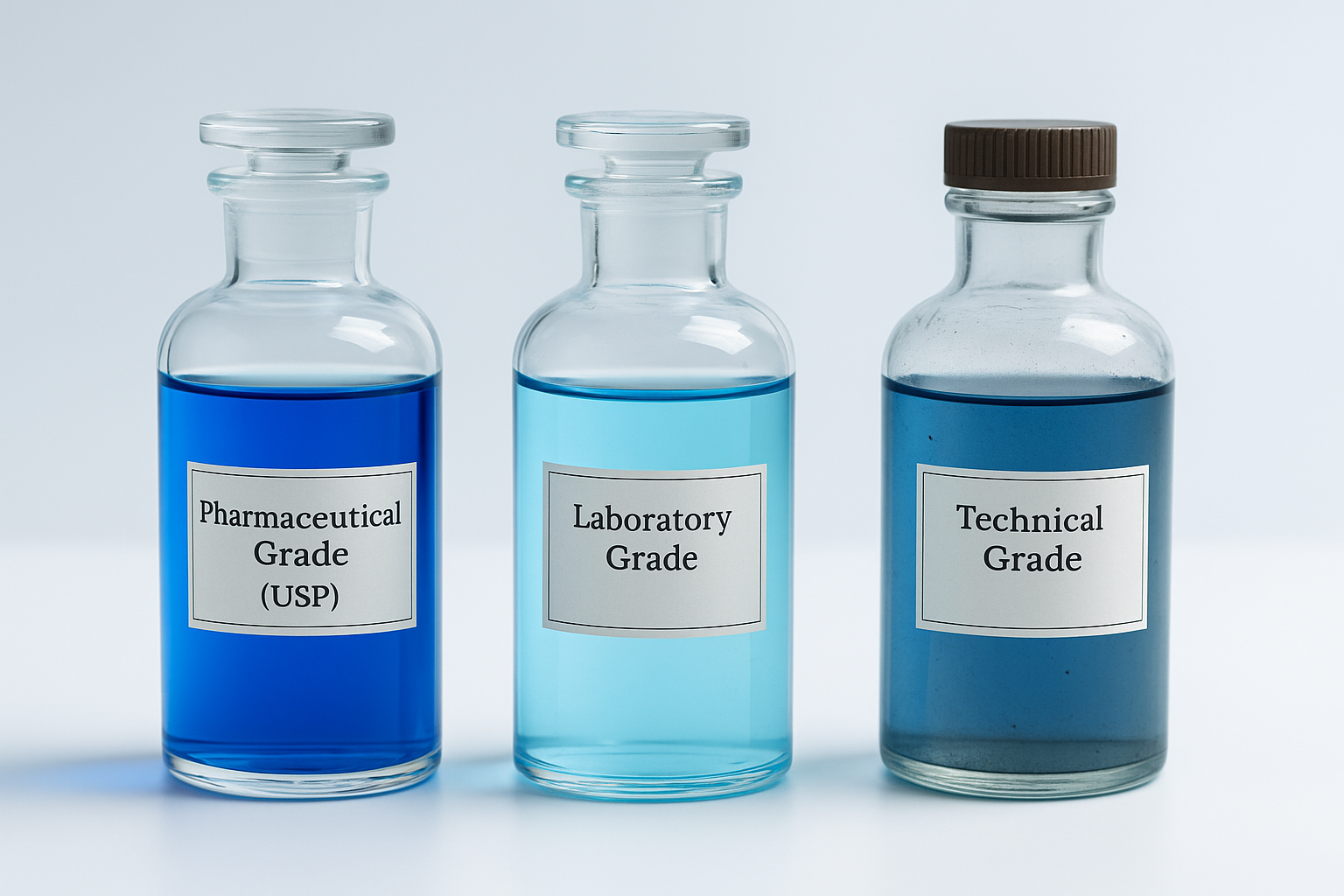
What are the differences in methylene blue?
Methylene blue is available in different purity levels:
- Pharmaceutical Grade (USP): for medical applications, with the highest purity standards and certified by independent laboratories.
- Laboratory quality: for scientific and research purposes.
- Technical grade: for industrial applications with lower purity requirements.
FAQ
Is methylene blue safe?
Is methylene blue safe?
Important note: According to the EU Novel Food Regulation, methylene blue is not approved as a food or food supplement in Germany or the European Union and should not be consumed! Methylene blue is highly coloring!
Methylene blue is generally safe when used correctly and according to instructions. It has been used in medicine and other fields for over a century. However, there are some important points to keep in mind:
Medical Uses: When used correctly and at the correct dosage under medical supervision, methylene blue is safe. It is used to treat methemoglobinemia, certain urinary tract infections, and other medical conditions. Medical supervision is important to avoid potential side effects and drug interactions.
Diagnostic and laboratory applications: In microscopy and biology, methylene blue is used in low concentrations as a staining agent and is safe in these applications.
Aquaristics: When dosed correctly, methylene blue is a proven and safe option for treating fish diseases.
However, there are some contraindications and risk groups:
G6PD deficiency: People with glucose-6-phosphate dehydrogenase deficiency should avoid methylene blue because it can cause hemolysis .
Pregnancy and breastfeeding: Use during pregnancy and breastfeeding is considered unsafe and should not be undertaken.
Keep away from children.
Interactions: It may interact with certain medications, including antidepressants , and increase the risk of serotonin syndrome . Always consult a doctor and tell them about all medications you are taking.
How long does methylene blue last?
How long does methylene blue last?
According to the specialist literature, methylene blue is an extremely stable chemical compound and has an almost unlimited shelf life when stored in a cool, dry place away from light.
How is methylene blue dosed?
How is methylene blue dosed?
Important note: According to the EU Novel Food Regulation, methylene blue is not approved as a food or food supplement in Germany and the European Union and must not be consumed!
A 1% methylene blue solution contains ~0.5mg methylene blue per drop.
According to specialist literature, this solution is additionally diluted in water (e.g. in 250ml water).
Application:
1st week: 10mg per day
2nd week: 20mg per day
3rd week: 30mg per day
In clinical studies, doses of up to 2mg/kg are used (e.g. 80kg = 160mg methylene blue = 320 drops of a 1% methylene blue solution).

Studies on methylene blue
Although methylene blue was discovered in 1876 , it remains one of the most exciting research substances in modern science . Since its discovery, methylene blue has been continuously studied—and even today , new mechanisms of action, applications, and potential health benefits are continually being discovered.
There are now over 10,000 scientific studies on methylene blue that address its biological, medicinal and cell-protective properties .
On this page you will find a selection of the most important studies and current research results on methylene blue – clearly summarized and explained in an understandable way.
From mitochondrial function to neuroprotection
From mitochondrial function to neuroprotection
Methylene blue (MB) is a well-established drug with a long history of use, valued for its diverse applications and minimal side effect profile . Classically, MB has been used to treat malaria , methemoglobinemia , and carbon monoxide poisoning , as well as as a histological stain. More recently, however, its role in mitochondria has attracted considerable interest. MB may divert electrons in the mitochondrial electron transport chain directly from NADH to cytochrome c , thereby increasing the activity of complex IV and promoting mitochondrial activity while mitigating oxidative stress. In addition to its protective effect on mitochondria, MB may attenuate neuroinflammatory processes. Mitochondrial dysfunction has been identified as a unifying pathological phenomenon in a variety of neurodegenerative diseases , making MB a promising therapeutic agent.
According to in vitro and in vivo studies, MB may demonstrate impressive efficacy in mitigating neurodegeneration and associated behavioral phenotypes in animal models of diseases such as stroke , global cerebral ischemia, Alzheimer's disease , Parkinson's disease , and traumatic brain injury . This review summarizes recent work that may establish MB as a promising candidate for neuroprotection , with particular emphasis on the contribution of mitochondrial function to neuronal health. Furthermore, this study briefly examines the relationship between MB, neurogenesis , and improved cognition in relation to age-related cognitive decline.
Source: From Mitochondrial Function to Neuroprotection-an Emerging Role for Methylene Blue
Molecular mechanisms of the neuroprotective effect of methylene blue
Molecular mechanisms of the neuroprotective effect of methylene blue
Methylene blue (MB) is the first fully synthetic compound introduced into medicine over 120 years ago as a treatment for malaria . MB is approved for the treatment of methemoglobinemia but also shows promising results as a neuroprotective agent in models of Alzheimer's , Parkinson's , and Huntington's diseases , traumatic brain injury , amyotrophic lateral sclerosis , and depressive disorders . The aim of this study, however, is not so much to highlight the therapeutic effects of MB in the treatment of various neurodegenerative diseases , but rather to investigate the mechanisms of its direct or indirect influence on signaling pathways. MB might act as an alternative electron transporter in the mitochondrial respiratory chain when the electron transport chain is dysfunctional. It also exhibits anti-inflammatory and anti-apoptotic effects, inhibits monoamine oxidase (MAO) and nitric oxide synthase (NOS) , activates signaling pathways involved in the renewal of the mitochondrial pool (mitochondrial biogenesis and autophagy), and prevents the aggregation of misfolded proteins. A comprehensive understanding of all aspects of MB's direct and indirect influence, not just some of its effects, could advance further research on this compound, including its clinical applications.
Source: Molecular Mechanisms of the Neuroprotective Effect of Methylene Blue
Methylene blue and its analogues as antidepressant compounds
Methylene blue and its analogues as antidepressant compounds
Methylene blue (MB) is valued for its diverse medical applications and is well-suited for the treatment of methemoglobinemia and ifosfamide-induced encephalopathy . In recent years, interest in MB as an antimalarial agent and potential treatment option for neurodegenerative diseases such as Alzheimer's disease has increased. Reports demonstrate antidepressant and anxiolytic potential of MB in preclinical models, as well as promising results from clinical trials in schizophrenia and bipolar disorder . MB is a known inhibitor of monoamine oxidase A (MAO-A) , which is an established target for antidepressant effects. Furthermore, MB non-selectively inhibits nitric oxide synthase (NOS) and guanylate cyclase . Dysfunction of the nitric oxide (NO) -cyclic guanosine monophosphate (cGMP) signaling pathway is closely linked to the neurobiology of mood, anxiety, and psychotic disorders, while inhibition of NOS and/or guanylate cyclase is associated with antidepressant activity. These effects could significantly contribute to the psychotropic activity of MB. Furthermore, these disorders are characterized by mitochondrial dysfunction and redox imbalance. By acting as an alternative electron acceptor /donor, MB restores mitochondrial function, improves neuronal energy production, and inhibits superoxide generation, which could also contribute to its therapeutic activity. MB may be a particularly relevant strategy in depression combined with neurodegenerative diseases such as Alzheimer's and Parkinson's . By considering their physicochemical and pharmacokinetic properties, MB analogues may offer therapeutic potential as novel multi-target strategies in the treatment of depression . In addition, analogues with low MAOI activity may offer equivalent or improved efficacy with a lower risk of side effects.
Source: Methylene blue and its analogues as antidepressant compounds
Anti-aging potential of methylene blue for the long-term health of human skin
Anti-aging potential of methylene blue for the long-term health of human skin
Oxidative stress1 is the main cause of skin aging , which includes wrinkles, pigmentation , and impaired wound healing ability . The application of antioxidants in skin care is recognized as an effective method to delay the skin aging process. Methylene blue (MB), a traditional mitochondria -targeting antioxidant , showed potent effects in scavenging reactive oxygen species (ROS) in cultured human skin fibroblasts obtained from healthy donors and patients with progeria , a genetic premature aging disease. Compared with other commonly used antioxidants , both general and mitochondria -targeting, it was found that MB could more effectively stimulate the proliferation of skin fibroblasts and delay cellular senescence . A skin irritation test on an in vitro reconstructed 3D model of human skin showed that MB is safe for long-term use even at high concentrations and does not cause irritation. The application of MB to this 3D skin model further demonstrated that MB could improve skin viability, promote wound healing , increase skin hydration, and enhance dermis thickness. Gene expression analysis showed that MB treatment altered the expression of several extracellular matrix proteins in the skin, including upregulation of elastin and collagen 2A1, two essential components for healthy skin. MB can circumvent complex I/III activity in mitochondria and mitigate oxidative stress to some extent. This review summarizes the latest studies on the applications of MB in the treatment of age-related conditions, including neurodegeneration , memory loss , skin aging, and the premature aging disease progeria.
Source 1: Anti-Aging Potentials of Methylene Blue for Human Skin Longevity Source 2: The Potentials of Methylene Blue as an Anti-Aging Drug
Influence of methylene blue on oxygen availability and blood flow during endotoxic shock
Influence of methylene blue on oxygen availability and blood flow during endotoxic shock
This randomized , controlled acute intervention study investigated the effect of methylene blue (MB) on endotoxic shock. Anesthetized, healthy dogs received endotoxin alone or in combination with increasing doses of MB. The study found that low and moderate doses of MB could significantly increase arterial blood pressure but had no effect on cardiac index . MB resulted in a dose-dependent increase in systemic and pulmonary arterial pressure and vascular resistance. However, at higher doses, MB worsened systemic hypotension, myocardial depression, and pulmonary hypertension. Interestingly, MB selectively increased blood flow in mesenteric and femoral arteries, while renal blood flow remained unaffected. The study suggests that MB has complex dose-dependent effects on hemodynamic parameters and regional blood flow during endotoxic shock, which could potentially impact its application in critical care.
Source: Effects of methylene blue on oxygen availability and regional blood flow during endotoxic shock
Methylene blue in Alzheimer's treatment
Methylene blue in Alzheimer's treatment
Methylene blue (MB) and its compounds are being investigated for their potential to treat Alzheimer's disease (AD), a widespread neuropathological disorder characterized by the gradual loss of cognitive abilities and the development of severe dementia . The prevalence of AD is projected to increase significantly due to the aging population. Histopathologically, AD is characterized by the presence of intracellular neurofibrillary tangles (NFTs) and extracellular amyloid plaques in the brain. Methylene blue, a thiophene dye with FDA approval for the treatment of several diseases, demonstrates easy crossing of the blood-brain barrier and may have potential therapeutic potential in central nervous system disorders. The literature review includes randomized clinical trials investigating the potential benefits of MB in the treatment of AD. The results of the studies show that MB administration has demonstrated improvements in cognitive function, reductions in the accumulation of beta-amyloid plaques, improvements in memory and cognitive function in animals, and antioxidant properties that may mitigate oxidative stress and inflammation in the brain. This review evaluates the most recent research on the use of MB for the treatment of AD.
The relationship between methylene blue and Alzheimer's disease has recently attracted increasing scientific attention due to the suggestion that MB could slow the progression of this disease. Indeed, in addition to its well-characterized inhibitory effects on the cGMP signaling pathway, MB influences numerous cellular and molecular events closely linked to the progression of AD. Recent studies show that MB could reduce the formation of amyloid plaques and neurofibrillary tangles and partially repair impairments in mitochondrial function and cellular metabolism. Furthermore, MB influences various neurotransmitter systems ( cholinergic , serotonergic, and glutamatergic ), which may play an important role in the pathogenesis of AD and other cognitive disorders. The combination of the various effects of MB on these cellular functions could potentially mediate beneficial effects of MB. This has led to attempts to develop novel MB-based treatment modalities for AD. This review summarizes the effects of MB on neurotransmitter systems as well as on several cellular and molecular targets and discusses their relevance to AD.
Source 1: Exploring Methylene Blue and Its Derivatives in Alzheimer's Treatment: A Comprehensive Review of Randomized Control Trials
Source 2: Methylene blue and Alzheimer's disease
Methylene blue 2% solution
Methylene blue 2% solution
BlueVitality 2% Methylene Blue – double concentration, maximum added value
Our 2% methylene blue solution contains twice as much high-purity USP methylene blue as the 1% version – with the same quality and composition. Manufactured in Germany, strictly controlled, and independently laboratory-tested – for the highest standards and an excellent price-performance ratio.
💧 Double concentration
2% USP Methylene Blue + purified water – for more active ingredient per drop.
💸 Efficient & productive
Fewer drops – same effect. Ideal for those who want to get more out of their product.
🔬 Laboratory tested
Independent analysis confirms purity and freedom from heavy metals (DIN EN 15763).
🇩🇪 Made in Germany
Production & bottling under the strictest quality standards.
💙 Precise dosing
100 ml light-protected glass bottle with pipette – approx. 2000 drops of 1 mg methylene blue per drop.
⚠️ Important note: According to the EU Novel Food Regulation, methylene blue is not approved as a food or food supplement in Germany and the European Union and must not be consumed!


